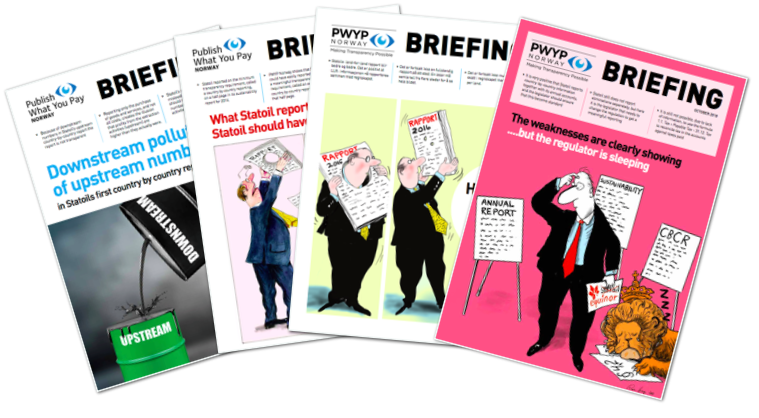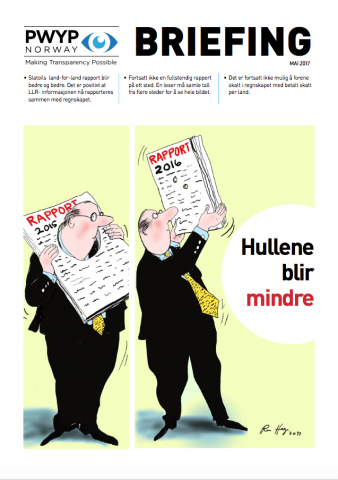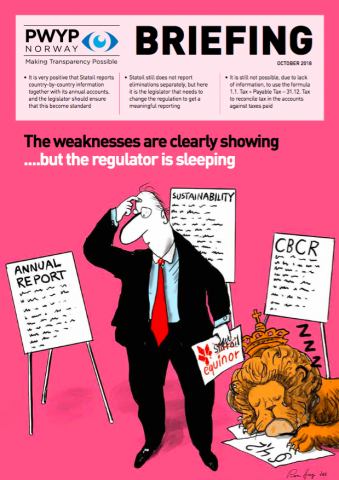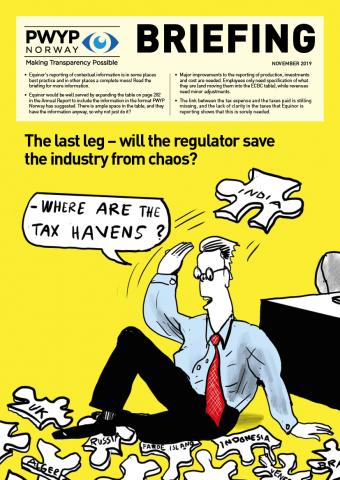
PWYP Norway has analyzed and documented Statoil`s reporting under the current country-by-country reporting amendment for the five financial years the company has reported - 2014, 2015, 2016, 2017, and 2018.
PWYP Norway does not know of other civil society organizations conducting similar analyses of what information emerges and evaluated the usefulness of the information as measured against the objective, but we are familiar with analysts and investors making use of the information. It is, however, not possible to estimate to what extent that analysts and investors use this information without conducting a survey.
Analysis of the financial year 2014

In 2014 PWYP Norway showed, by using available data from Statoil`s CBCR report, that Statoil had mixed downstream numbers in a report on upstream numbers (Downstream numbers pollute upstream numbers, 2014) and showed both erroneous reporting and incomplete reporting.
The downstream numbers in Statoil`s country-by-country reporting on upstream numbers caused the reporting not to be transparent. This provided a basis for and led to media reports and a parliamentary debate.
The use of data and the attention that followed caused Statoil to change their reporting the following financial year. Unfortunately, 2014 is not a representative year for CBCR reporting in Norway because the erroneous reporting was never corrected.
Analysis of the financial year 2015

In our analysis of Statoil`s CBCR report in 2015 ("What Statoil reported and what Statoil ought to have reported", 2015) PWYP Norway revealed that Statoil easily could have reported on a meaningful transparency requirement, called extended country-by-country reporting, on just one page.
Statoil reported «purchase of goods and services» instead of «expenses”, but cannot solely be faulted for insufficient reporting of expenses in this report, as they followed a faulty amendment. However, the reporting clearly showed that even a large company such as Statoil can report the required main information on one page. This is one reason why PWYP Norway believes that the main information should be added as a disclosure, and not just a supplementary reporting. The connection to the accounting information where these numbers derive from then becomes more explicit, the information must be tied to the accounting numbers, and since the accounting numbers are already revised, no additional revision is needed.
Analysis of the financial year 2016

Our analysis of Statoil`s CBCR report in 2016 (“The holes are shrinking”, 2016 (”Hullene blir mindre”, 2016), shows that Statoil`s country-by-country reporting gets better and better. It is a positive improvement that CBCR information is now reported with the accounts, even if it is still not a part of the annual accounts themselves. Even so, it is still not a complete report of the main information in one place. A reader must gather numbers from several places in order to see the whole picture and it is still not possible to reconcile paid taxes in the accounting with paid taxes per country.
It has been argued by the industry that the accounting does not show paid taxes, but that is not the case. All taxes in the accounting are paid taxes (which have gone out of account). It is not until one creates the annual account that one creates tax provisions to show what is left to pay of taxes next year. Before adding the tax provision, all information on taxes in the accounting concerns paid taxes. The industry`s and the audit industries` argument to keep the main information outside the notes to the annual accounting therefore does not hold. In addition to paid taxes in the accounting one finds those payments to authorities that are NOT a part of the accounting, typically authorities` share of the Production Sharing Agreement (PSA). These taxes can, however, be reported outside the note, because these numbers are not in the financial statements. The note should only inform about paid taxes and expenses in the accounting, while other additional information is reported in the CBCR report.
Analysis of the financial year 2017

In the 2017 analysis the improvements in reporting continued: "The weaknesses are clearly showing ...but the regulator is sleeping"
- t is very positive that Statoil is reporting country-by-country information with the annual accounts, and legislator should ensure that this becomes the standard.
- Statoil still does not report eliminations separately, but here it is the legislator who must change the amendment to acquire meaningful reporting.
- It is still not possible to utilize the formula 1.1. tax + payable tax – 31.12 tax to reconcile taxes in the accounting against paid taxes.
Analysis of the financial year 2018

Our analysis of Equinor`s reporting of extended information revealed in some places best practice and other places a very messy interpretation.
Equinor would be well served to expand the table on page 282 in the annual report to include information in the format that PWYP Norway has proposed. There is plenty of space in the table, and they have the information regardless – so why not just do it?
The reporting of production, investments, and expenses needs a lot of improvement, while for the employees only a specification of what is utilized (FTE or employees) and move or duplicate the reporting in the CBCR table. The revenue needs only minor adjustments. The connection between the tax expenses and paid taxes is still missing, and the confusion in the taxes that Equinor is reporting, shows that this is sorely needed.
Read the briefing: "The last leg - will the regulator save the industry from chaos?"
How are the analyses used?
The first analysis in 2014 was the one that caught the most attention with large media publications and debate in Parliament. The public debate is, however, only one aspect of the CBCR reporting. More important is how the numbers are factually utilized, and this is where analysts and investors are the largest user groups.
Where PWYP Norway`s own use is concerned, the first analysis is published in both Norwegian, English, and Spanish, the second analysis is published in Norwegian and English, while the third analysis is only published in Norwegian. The analyses are spread through our international network and picked up by local news media such as in Angola. For example Deutsche Welle, in connection with the case ”Poderão as empresas petrolíferas financiar a corrupção em Angola?” ( dw.com 15. april 2016), published an interview with PWYP Norway on Statoil and Angola.
PWYP Norway`s assessment is that it is an informed civil society that makes democracy possible, and an accountability process in Angola will necessarily take time, since the dictator in Angola can maintain his power through financing through precisely the financial mechanisms that PWYP Norway wants to eliminate. A prerequisite for building authoritarian regimes is precisely the opportunity to enrich oneself at the community`s expense and to be able to hide their tracks.
PWYP Norway wants to point out that a simple measure for transparency – within a sector – is by itself not sufficient to “hold authorities accountable.” At the same time, we believe transparency by itself is inherently good for societies and so citizens can have an informed debate, which is a prerequisite for democracy.
Open societies have some qualities and common denominators that closed societies do not have. This is easily retrievable in existing literature. There is also a lot to gain from Norwegian defense studies on how demanding it is to keep authorities responsible in «closed societies», for example Angola and Russia. That can also be challenging in «open societies”. We can also observe that the already adopted transparency demand which should have held authorities accountable, was removed by the authorities themselves in the USA when Trump came to power
The globalization of the CBCR principles in their right context – and why they are so important – are themselves important in order to enable the various players to hold authorities responsible.
Read more: «Extended country-by-country reporting» and «Which measures do we propose?”
